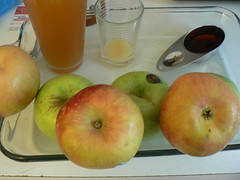
ingredients
Originally uploaded by stu_spivack.
Apples are a traditional Rosh Hashana food. It's common to eat them with honey as a symbol of the sweetness that Jews hope for in the coming year. That's 5767 in the Jewish calendar, by the way. Also, the phrase "land of milk and honey" has an interesting history. The holy land never really had either milk or honey in biblical times. The popularity of that phrase in English must date to a period of time when those English words had different meanings. In the Hebrew, milk refers to a milk-like substance pressed from almonds and honey refers to a honey-like substance pressed from dates(?).
Here are some links related to the holiday. Most are written to a Jewish-literate audience but may be of general interest. The Orthodox Union, primaril responsible for maintaing Jewish dietary standards, some information. Chabad, an organization afiliated with the Chasidic Lubavitch sect also has some information.
The shofar is one of the most emblematic symbols of the High Holidays.
The traditional holiday greeting is "La shana tova" - "to a good year."
Tonigh begins the first day of Rosh Hashana. Days on the Jewish calendar begin and end at sundown. Tishrei is the first month of the Jewish year and traditionally Tishrei 1 is the anniversary of the completion of the creation of the Earth. The two day observance of Rosh Hashana is an artifact of an abandoned system of tracking the Jewish calendar. Months on the Jewish calendar are lunar and begin with the new moon. Long after it was possible to predict lunar events, the official reckoning of the calendar was still tied to actual obervation of the moon. News of the new month was passed slowly over great distances from Jerusalem so the exact date was not always easily determined in all places. Two day celebrations increased the chance that the true day of the holiday was honored. After the calendar was tied to astronomical formula, the tradition of two day observances (but only outside of Jerusalem) was maintained. (Wikipedia lists this as only one of two possible explanations but, as far as I now, it is the predominant folk etymology of the tradition. The other explanation is interesting, too.
Rosh Hashana begins a ten day period of repentance which culminates in Yom Kippur (the day of atonement). During these days Jews believe that they're judged. On Yom Kippur they're sealed into either the Book of Life or the other book




No comments:
Post a Comment